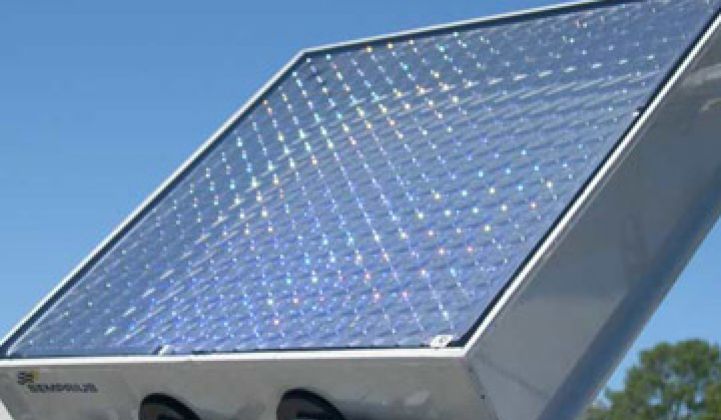Semprius has a core semiconductor technology the firm believes can make concentrating photovoltaics (CPV) a competitive solar technology.
Semprius and the CPV industry has its work cut out for it. The flat panel photovoltiacs (PV) industry has grown at a compound annual rate of about 41 percent per year for the last decade to reach its current 2010 shipment pace of 15 gigawatts.
CPV, despite its promise, has not really gotten out of the gate, and 2010 CPV installations are still well under 10 megawatts.
While silicon and thin-film PV ramp up shipments amidst plunging prices, CPV is mired in a chicken-and-egg problem of needing volume to drive down costs but not getting to volume because of high prices.
There has been some cause for hope. Amonix, armed with a 25-megawatt power purchase agreement (PPA) from Southern California Edison, seems to be one of the few CPV firms with the technology and financial runway to make CPV work. SolFocus has gotten some CPV traction in Saudi Arabia. Concentrix, now owned by Soitec, has shown some signs of life and has partnered with Johnson Controls. Some folks believe early-stage Morgan Solar has a chance. Optical networking giant JDSU has entered the CPV semiconductor contest. There's also rooftop CPV from Soliant.
Ben Kortlang, a partner at Kleiner Perkins and investor in Amonix, claimed that CPV from Amonix, "is cheaper than First Solar." First Solar is currently at about $0.77 per watt with their thin-film solar panels, so those are bold words from KP.
Spun out of the University of Illinois and founded in 2005, Semprius raised a $4.7 million round A in 2007, and more recently, won an additional $7.9 million from Applied Ventures, ARCH Venture Partners, GVC Investment Fund, Intersouth Partners, In-Q-Tel, Illinois Ventures and X-FAB Semiconductor Foundries.
The 30-employee firm aspires to be a vertically integrated manufacturer of high-concentration PV (HCPV) panels using their own gallium arsenide (GaAs) micro transfer printing-based chips while selling the panels to system integrators for mounting on 2-axis trackers.
Semprius does its own cell design and outsources the epi. Their micro transfer printing technology allows the firm to reuse the GaAs substrate rather than shipping the expensive substrate out the door with every cell. Semprius claims that by reusing the substrate, they can reduce the cost by fifty percent. The cell structure is grown on top of a release layer so that the cells can be epitaxially lifted off as part of the micro-transfer printing process.
The Semprius GaAs double-junction cells measure 600 microns by 600 microns, 300 times smaller than the standard industry cells, which in turn results in fewer defects, better quality, and the use of less current and therefore less heat through the cell, according to Bob Conner, the VP of Photovoltaics at Semprius. Smaller chips also mean smaller optical elements and simpler optics, as well as a smaller module size. Less heat means that Semprius can dispense with the heat sinks and heat spreaders used by the majority of CPV players. Conner hails CPV as having the highest conversion efficiency, lowest temperature degradation and the highest capacity factor of all solar power technologies.
Semprius claims a 32 percent efficiency at 1,000 suns for their double-junction cells -- that's close to the world's best performance. The firm expects their triple-junction cells to have efficiencies in the high thirties. A silicone-on-glass lens array concentrates the sunlight onto a small glass ball lens which illuminates the microcell and provides a +/-0.8 degree angle of acceptance at 1000x concentration.
Semprius deployed one of their systems at Tucson Electric Power (TEP) in August of this year using their modules and an automated solar tracking system developed by Siemens. The tracker, which uses a Siemens automation system and NREL’s Solar Positioning Algorithm, provides a tracking accuracy of better than 0.2 degrees.
In order to be successful, Semprius needs to be better than all other HCPV companies and comparable to the very best wafer silicon and thin-film module companies. At the rate costs are dropping for silicon solar panels, that is a very high hurdle.
Nancy Hartsoch, VP at SolFocus, estimates that the amount of CPV shipped in 2010 will be 12 megawatts to 15 megawatts with an "installed base of about 8 megawatts." She suggests that 2011 will see 100 megawatts shipped, a substantial growth curve.
According to the soon-to-be-released CPV report from GTM Research, annual CPV installations will grow from 2 megawatts in 2009 in to 750 megawatts in 2015. Those numbers imply the market doubling every year for the next six years, growing much faster than the PV market as a whole. If accurate, 750 megawatts of CPV in 2015 would account for about 2.5 percent of the total solar PV market, remaining a specialized solution suited for locations with poor water resources, and high DNI
This is an aggressive forecast and will require the cooperation of developers and banks in accepting the LCOE and reliability projections of the leaders in CPV - Amonix, SolFocus and Concentrix.



